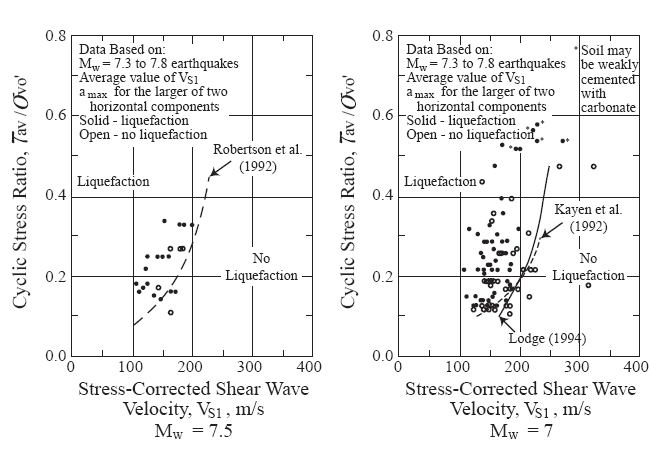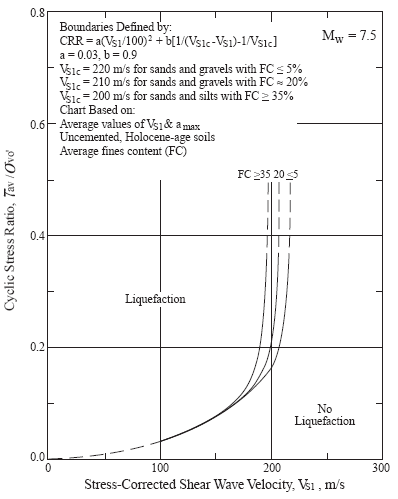Vs-Based CRR
The CRR7.5 based on VS is calculated based on the following methodology (source: NCEER Workshop 1997 report):
Recommended Method by NCEER, 1997Robertson et al. (1992) proposed a stress-based liquefaction assessment procedure using field performance data from sites in the Imperial Valley, California. These investigators normalized VS by:
VS1 = VS(Pa/σ′vo)0.25
where Pa is a reference stress of 100 kPa, approximately atmospheric pressure, and σ′vo is effective overburden pressure in kPa. Robertson et al., 1992 suggested the liquefaction resistance bound (CRR curve) for magnitude 7.5 earthquakes, plotted in the following figure along with several sites where liquefaction did or did not occur. Subsequent liquefaction resistance boundaries proposed by Kayen et al., 1992 and Lodge, 1994 for magnitude 7 earthquake are also shown. Figure 1 : Proposed cyclic stress ratio based on shear wave velocity.
The relationship proposed by Lodge (1994) provides a conservative lower boundary for liquefaction case histories with VS1 less than about 200 m/s. The relationship by Robertson et al. (1992) is the least conservative of the three. Professor Ricardo Dobry suggested a relationship between cyclic resistance ratio and VS1 for constant average cyclic shear strain; This formula supports a CRR bound passing through the origin and provides a rational approach for extrapolating beyond the limits of the available field performance data, at least for lower values of VS1 (VS1 ≤ 125 m/s).
where VS1c is the critical value of VS1 which separates contractive and dilative behavior, and a and b are curve fitting parameters. Using the relationship between VS1 and CRR expressed by this equation , Andrus and Stokoe drew curves to separate data from sites where liquefaction effects were and were not observed. Best fit values for the constants a and b were 0.03 and 0.9, respectively, for magnitude 7.5 earthquakes. Andrus and Stokoe also determined the following best-fit values for VS1c :
This minimal CRR value is generally consistent with intercept CRR values for the CPT and SPT procedures.
Figure 2 : Proposed cyclic stress ratio curves for different fines content (FC).
|

